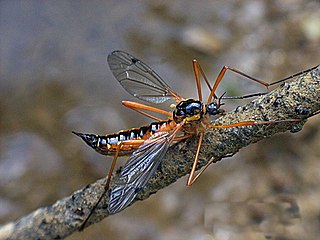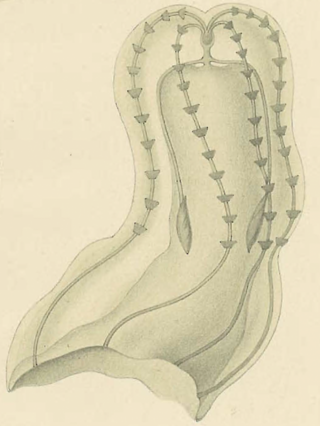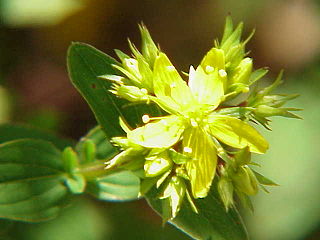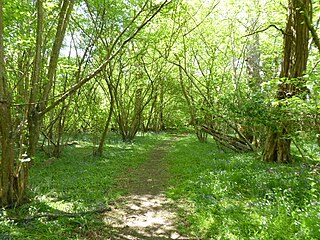
Caenorhabditis elegans is a free-living transparent nematode about 1 mm in length that lives in temperate soil environments. It is the type species of its genus. The name is a blend of the Greek caeno- (recent), rhabditis (rod-like) and Latin elegans (elegant). In 1900, Maupas initially named it Rhabditides elegans. Osche placed it in the subgenus Caenorhabditis in 1952, and in 1955, Dougherty raised Caenorhabditis to the status of genus.

Ctenophora comprise a phylum of marine invertebrates, commonly known as comb jellies, that inhabit sea waters worldwide. They are notable for the groups of cilia they use for swimming, and they are the largest animals to swim with the help of cilia.

A nerve net consists of interconnected neurons lacking a brain or any form of cephalization. While organisms with bilateral body symmetry are normally associated with a condensation of neurons or, in more advanced forms, a central nervous system, organisms with radial symmetry are associated with nerve nets, and are found in members of the Ctenophora, Cnidaria, and Echinodermata phyla, all of which are found in marine environments. In the Xenacoelomorpha, a phylum of bilaterally symmetrical animals, members of the subphylum Xenoturbellida also possess a nerve net. Nerve nets can provide animals with the ability to sense objects through the use of the sensory neurons within the nerve net.

Tentaculata is a class of comb jellies, one of two classes in the phylum Ctenophora. The common feature of this class is a pair of long, feathery, contractile tentacles, which can be retracted into specialised ciliated sheaths. In some species, the primary tentacles are reduced and they have smaller, secondary tentacles. The tentacles have colloblasts, which are sticky-tipped cells that trap small prey.

In zoology, a tentacle is a flexible, mobile, and elongated organ present in some species of animals, most of them invertebrates. In animal anatomy, tentacles usually occur in one or more pairs. Anatomically, the tentacles of animals work mainly like muscular hydrostats. Most forms of tentacles are used for grasping and feeding. Many are sensory organs, variously receptive to touch, vision, or to the smell or taste of particular foods or threats. Examples of such tentacles are the eyestalks of various kinds of snails. Some kinds of tentacles have both sensory and manipulatory functions.

Radiata or Radiates is a historical taxonomic rank that was used to classify animals with radially symmetric body plans. The term Radiata is no longer accepted, as it united several different groupings of animals that do not form a monophyletic group under current views of animal phylogeny. The similarities once offered in justification of the taxon, such as radial symmetry, are now taken to be the result of either incorrect evaluations by early researchers or convergent evolution, rather than an indication of a common ancestor. Because of this, the term is used mostly in a historical context.

Coelenterata is a term encompassing the animal phyla Cnidaria and Ctenophora. The name comes from Ancient Greek κοῖλος (koîlos) 'hollow', and ἔντερον (énteron) 'intestine', referring to the hollow body cavity common to these two phyla. They have very simple tissue organization, with only two layers of cells, and radial symmetry. Some examples are corals, which are typically colonial, and hydrae, jellyfish, and sea anemones, which are solitary. Coelenterata lack a specialized circulatory system relying instead on diffusion across the tissue layers.

The blue-tailed damselfly or common bluetail is a damselfly, belonging to the family Coenagrionidae.

Ctenophora is a genus of true crane flies. The species are large, shiny black craneflies with large yellow, orange, or red markings to mimic wasps. Males have comb-like antennae. The larvae are saproxylic. The species are confined to old deciduous forests, orchards, and other habitats with continuity of the presence of dying and fallen trees. Ctenophora species are important bioindicators.

Platyctenida is an order of comb jellies in the class Tentaculata.
Chaetonotus elegans is a species of gastrotrichs in the genus Chaetonotus. It is found in freshwater of Europe.
Somatina ctenophora is a moth of the family Geometridae. It is found in Kenya, Namibia and South Africa.

Beroe, commonly known as the cigar comb jellies, is a genus of comb jellies in the family Beroidae. Beroe exhibits bioluminescence.

ParaHoxozoa is a clade of animals that consists of Bilateria, Placozoa, and Cnidaria. The relationship of this clade relative to the two other animal lineages Ctenophora and Porifera is debated. Some phylogenomic studies have presented evidence supporting Ctenophora as the sister to Parahoxozoa and Porifera as the sister group to the rest of animals. Other studies have presented evidence supporting Porifera as the sister to Parahoxozoa and Ctenophora as the sister group to the rest of animals, finding that nervous systems either evolved independently in ctenophores and parahoxozoans, or were secondarily lost in poriferans.

Ganesha is a genus of comb jellies. It is the only genus in the monotypic family Ganeshidae and the order Ganeshida. They are characterized by pair of small lobes round the mouth, and extended pharynx. Two species are currently recognized: Ganesha elegans and Ganesha annamita.

Hypericum elegans is a species of flowering plant in the St. John's wort family Ericaceae. It is native to Europe.

Neis is a genus of nudan ctenophores. It is a monotypic genus containing the single species Neis cordigera. It occurs only near Australia. As all beroids, it is a free-swimmer that form part of the plankton.

Epsom and Ashtead Commons are a 360.4-hectare (891-acre) biological Site of Special Scientific Interest on the outskirts of Epsom and Ashtead in Surrey. Epsom Common is a local nature reserve, and Ashtead Common is a national nature reserve, The site also includes a triangular enclosure which is a Scheduled Monument

Fyning Moor is a 12.8-hectare (32-acre) biological Site of Special Scientific Interest south of Fyning in West Sussex.
The Daf-9 gene encodes a cytochrome p450 enzyme catalysis the generation of dafachronic acid in the worm Caenorhabditis elegans, with the CYP Symbol CYP22A1. After generation, dafachronic acid will binding it's nuclear receptor Daf-12 and has been implicated by Cynthia Kenyon and colleagues related to the formation of Dauer larva.

















